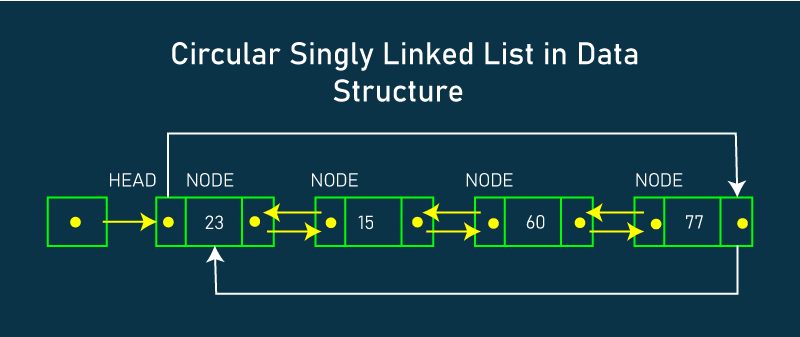Advantages and Disadvantages of Circular Linked ListIntroductionCircular Linked List is one data structure that simplifies programming concepts. Linked Lists are commonly used in data structures in high-level, intermediate, and low-level programming languages. Each data structure (Array or linked list) has its advantages and uses. Programmers who plan to include a Circular Linked list into their programming syntax in order to optimize, scale and design their programs need to be aware of the advantages and disadvantages. About Circular Linked List
A linked list usually contains a null node (a node that does not have a reference) at its end. A circular linked list, on the other hand, is a special type of list where the last node points back towards the first node, which is the start. The start node serves as a point of reference for the list's beginning. The Circular Linked List is empty if the start equals Null. You can start at any node, and you can traverse the list in any direction until you reach the same node from where you started, A circular linked list does not have a beginning or an end. The address of the first node is stored in the last node's address, forming a circular link-like structure. Applications of Circular Linked ListThe following can be done with Circular Linked Lists:
Real-Life Use of Circular Linked List
Basic operations in Circular Linked ListA circular linked list is essentially composed of the following operations:
Advantages of Circular Linked ListThere are many benefits of circular linked lists in modern programming concepts, from traversal to implementation. Those mentioned below are just a few- 1. Dynamic data structure Linked lists can be dynamic and grow or shrink at will by allocating memory and flushing it. It doesn't matter if the linked lists are single, double, or circular. All you need to do is know the elements. 2. Memory Utilization It is one advantage of Circular Linked lists. Unlike linear data structures, they allow you to use memory efficiently because the linked list's length changes or decreases dynamically. This means that there is no memory waste. You don't need to allocate the memory beforehand. 3. Implementation is easy Because of the ease of data manipulation and memory usage, linear data structures such as stacks and queues can often be easily implemented with a linked list. 4. Data manipulation made easy You can insert or delete from the circular linked lists without needing to restructure them. After the insertion or removal of an element, there is no need for it to be moved. Only the address in the next pointer must be updated. Disadvantages of Circular-Linked ListThere are some disadvantages to Circular Linked List. These may occur while using stacks and include the fact that you may not be able to manipulate data using PUSH or POP Operations. 1. Memory usage Because memory allocation in circular linked lists happens at runtime, they require more memory than arrays or linear data structures like stacks. A pointer is required in a node to store the address for the next element. It also requires additional memory. 2. Traversal is among the biggest drawbacks of Circular Linked Lists The last node of circular linked lists refers to the beginning node. If it is not traversed with care, you could end up in an endless loop. In circular linked lists, the traversal process is lengthier. Access to all elements isn't feasible in a linked list like an array with an index. 3. Reverse Traversing Circular linked lists can be more difficult when compared to singly or doubly linked lists. Reversely traversing circular linked lists is only possible if you have an additional quantity of memory. In order to reverse-traverse, the memory requirement is increased to store that back pointer. This means that there is a waste of memory. 4. Random Access Access to random data is not possible with linked lists because of their dynamic allocation of memory. Like double lists and single lists, circular linked lists cannot support direct access to elements. This is the main drawback of circular linked lists. Conclusion on the Advantages and Disadvantages of the Circular Linking List From gaming to contemporary internet browsers, Circular linked lists are renowned for their usability and are used in a variety of ways. Understanding the benefits and disadvantages of Circular linked lists is a good way to get a notion of their usefulness in everyday tasks. If you ever click the back button in the browser or do the undo button when using MS Office, remember that's only possible due to Circular Linked List. |
 For Videos Join Our Youtube Channel: Join Now
For Videos Join Our Youtube Channel: Join Now
Feedback
- Send your Feedback to [email protected]
Help Others, Please Share










